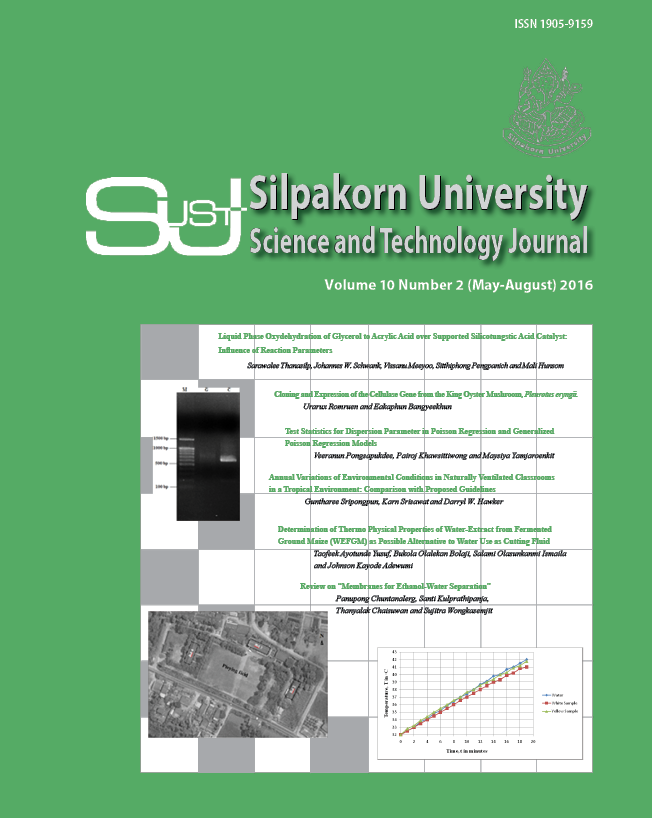Annual Variations of Environmental Conditions in Naturally Ventilated Classrooms in a Tropical Environment: Comparison with Proposed Guidelines
Main Article Content
Abstract
Internal classroom conditions are important aspects of the learning environment of students. A suite of relevant guidelines for acoustic, visual and thermal comfort parameters in naturally and/or mechanically ventilated classrooms in tropical environments is proposed. Data measured during winter and rainy seasons in a typical provincial school in central Thailand were then compared. Only thermal parameters, viz. wet bulb globe temperature, air temperature and relative humidity met the proposed guidelines values at all times during the school year. Mean sound levels and signal-to-noise ratios did not meet the requirements at some time during this period. Mean illuminance in classrooms only reached proposed guideline values when all internal lights were operating which occurred mainly during the rainy season. Illuminance in front of blackboards and whiteboards never reached proposed thresholds at any time.
Downloads
Article Details
References
Bradshaw, V. (2006). The Building Environment: Active and Passive Control Systems, 3rd ed.,New York: John Wiley & Sons, Inc., pp. 3-37.
Budd, G. M. (2008). Wet-bulb globe temperature (WBGT) - its history and its limitations. Journal of Science and Medicine in Sport, 11(1): 20-32.
Chenvidyakarn, T. (2007). Review article: Passive design for thermal comfort in hot humid climates. Journal of Architectural/Planning Research and Studies in the World, 5(1): 3-27.
Chiang, C. M. and Lai, C. M. (2008). Acoustical environmental evaluation of joint classrooms for elementary schools in Taiwan. Building and Environment, 43(10): 1619-1632.
Choi, J. H., Beltran, L. O., and Kim, H. S. (2012). Impacts of indoor daylight environments on patient average length of stay (ALOS) in a healthcare facility. Building and Environment, 50(4): 65-75.
De Giuli, V., Da Pos, O., and De Carli, M. (2012) Indoor environmental quality and pupil perception in Italian primary schools. Building and Environment 56(10): 335-345.
Djongyang, N., Tchinda, R., and Njomo, D. (2010). Thermal comfort: A review paper. Renewable Sustainable Energy Reviews, 14(9): 2626-2640.
En, J. T. Y., Abidin, W. A. W. Z., Baharun, A., and Masri, T. (2014). A review of technological developments in cooling system for different climates. Middle-East Journal of Scientific Research, 21(9): 1503-1511.
Hwang, R. L., Lin, T. P., and Kuo, N. J. (2006). Field experiments on thermal comfort in campus classrooms in Taiwan. Energy and Buildings, 38(1): 53-62.
Ibrahim, S. H., Baharun, A., Abdul Mannan, M. D., and Abang Adenan, D. A. (2013) Importance of thermal comfort for library building in Kuching, Sarawak. Energy and Environment, 4(6): 1003-1012.
Ibrahim, S. H., Baharun, A., Modh Nawi, M. N., and Junaidi, E. (2014). Analytical studies on levels of thermal comfort in typical low-income houses design. UNIMAS e-Journal of Civil Engineering, 5(1): 28-33.
James, A. D. and Christian, K. (2012). An assessment of thermal comfort in a warm and humid school building at Accra, Ghana. Advances in Applied Science Research, 3(1): 535-547.
Khedari, J., Yamtraipat, N., Pratintong, N., and Hirumlabh, J. (2000). Thailand ventilation comfort chart. Energy and Buildings, 32(3): 245-249.
Panjaitan, S. D. and Hartoyo, A. (2011). A lighting control system in buildings based on fuzzy logic. Telkomnika 9(3): 423-432.
Salleh, N. M., Kamaruzzaman, S. N., and Mahyuddin, N. (2013). Sick building symptoms among children in private pre-schools in Malaysia: Association of Different Ventilation Strategies. Journal of Building Performance, 4(1): 73-81.
Shrestha, H. D., Pribadi, K. S., Kusumastuti, D., and Lim, E. (2009). Handbook of Typical School Design (general) 2 Classrooms and 3 Classrooms. Save the Children, Construction Quality & Technical Assistance (CQTA) in Collaboration with Center for Disaster Mitigation-Institute of Technology Bandung (CDM-ITB), Bandung, Indonesia.
Tantasavasdi, C., Srebric, J., and Chen, Q. (2001). Natural ventilation design for houses in Thailand. Energy and Buildings, 33(8): 815-824.
Thailand Department of Labor Protection and Welfare, Ministry of Labor (TDLPW). (2006). Guideline for administration and management of occupational safety, health and work environment in relation to heat, light and noise. According to the Royal Thai Government Gazette, Volume 123, Section 23 (March 6, 2006), Bangkok: Ministry of Labor, Thailand.
The Bureau of Indian Standards (BIS). (1995) Handbook on Functional Requirements of Buildings (other than industrial buildings) (Part 1-4), New Delhi: The Bureau of Indian Standards., pp. 77-98.
Wafi, S. R. S., and Ismail, M. R. (2008). The relationship between thermal performance, thermal comfort and occupants: A study of thermal indoor environment in selected students accommodation in Universiti Sains Malaysia (USM), Penang. In Proceeding of the 2nd International Conference on Built Environment in Developing Countries, Penang, Malaysia.
Winterbottom, M. and Wilkins, A. (2009) Lighting and discomfort in the classroom. Journal of Environmental Psychology 29(1): 63-75.
Wong, N. H., and Jan, W. L. S. (2003). Total building performance evaluation of academic institution in Singapore. Building and Environment, 38(1): 161-176.
Yamtraipat, N., Khedari, J., and Hirunlabh, J. (2005). Thermal comfort standards for air conditioned buildings in hot and humid Thailand considering additional factor of acclimatization and education level. Solar Energy, 78(4): 504-517.
Zhang, Y., Wang, J., Chen, H., Zhang, J., and Meng, O. (2010). Thermal comfort in naturally ventilated buildings in hot-humid area of China. Building and Environment, 45(11): 2562-2570.


